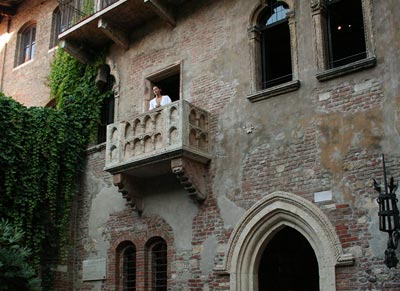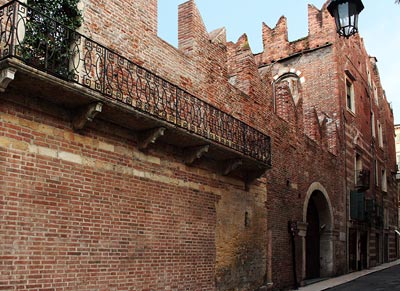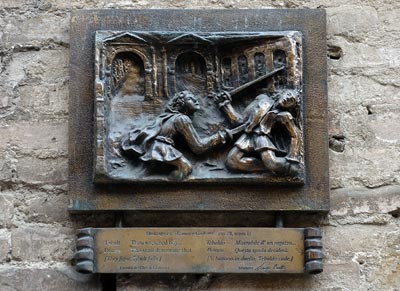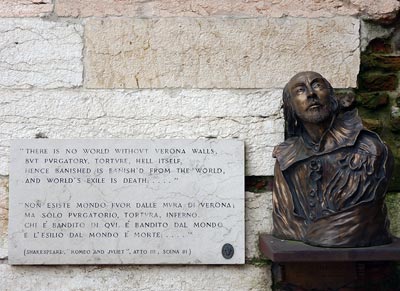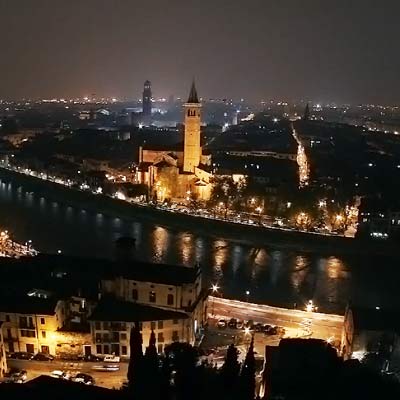Juliet's House

Juliet's house is a tower house from between late 13th and early 14th century. On a stone in the wall there is a bas-relief of a hat. Popular tradition considers it the coat of arms of the Cappelletti or Capuleti, Juliet's family. In the English version of the story it became "Capulets".
At the beginning of the 20th century Juliet's house was restored and opened to visitors.
Oncoming Tours
Info and Bookings:
+39 333 2199 645 info@veronissima.com P.I. 03616420232 C.F. CPPMHL74L13L781C
Historical Background

In '700 Verona became part of the Grand Tour. European nobles and artists who came to the city wanted to visit the places of the legend of Romeo and Juliet. They took them to see a building with a stone's throw from the central Piazza Erbe. In the keystone of the entrance arch is carved a hat, perhaps the coat of arms of the family who lived there in the Middle Ages.
Popular tradition said that it was the Capuleti family, or Cappelletti (which in Italian means "small hats"), translated as "Capulets" in the English version.
Restauration
Over the centuries the building had been altered and appeared as an anonymous and shabby 19th century building.
At the beginning of the 20th century Antonio Avena, architect and director of the Verona Museums , started the restoration, trying to bring back its medieval look.

Much of the original structure and interior was lost. Avena resorted to imagination and personal taste, adding decorative elements here and there. He didn't worry too much about historical accuracy, more interested in the overall look as the restoration.
The result was a great success. Visitors to the House of Juliet didn't care how original it was. They just wanted a suggestive place where they could fantasize about their favourite history and heroine.
What woman wouldn't want to feel for a moment like Juliet, looking out onto the famous balcony?
Today it is one of the most visited monuments in Italy.
Juliet's Statue
For I will raise her statue in pure gold;
That while Verona by that name is known.
There shall no figure at such rate be set
As that of true and faithful Juliet.

These are the words Romeo's father speaks at the end of Shakespeare's tragedy.
As if to comply with the words of Montecchi, in 1968 Veronese artist Nereo Costantini was commissioned a statue of Juliet. It was placed in the courtyard of the house, just under the famous balcony. Instead of gold he used bronze.
A few years ago the original statue was moved from the courtyard into Juliet's house. Exposed to the elements and the "assaults" of the visitors, it was getting damaged. It was thus replaced by a faithful replica with which visitors can snap selfie.
The Inside
The building consists of a tower, now lower than in the past, overlooking Via Cappello street, and a residential wing on two floors accessed from the courtyard. The interior of Juliet's house has been completely rebuilt. They used architectural and decorative elements from medieval period, either original or replicas. Over the years, the furniture has been enriched with additional pieces and paintings, either antique or in style, to create a suggestive atmosphere.
As soon as you go up the stairs to the first floor you will find yourself in the room from which you access the balcony. In high season there is often a queue to take photos.
The Party Hall

On the second floor of the residential wing is the largest room in the entire building. It has been renamed "the ballroom". It is not difficult to imagine here the party where Romeo and Juliet meet for the first time.
The setting is characterized by a large fireplace with the coat of arms of the Capulets. On the walls some 16th century frescoes and a collection of antique prints with the theme "Romeo and Juliet".
Juliet's Bedroom

On the first floor of the tower, in a more intimate space, is the "bedroom". Here was placed the bed used in the movie "Romeo and Juliet" by Italian director Franco Zeffirelli, one of the most famous versions of the story. It is the work of Veronese carpenters. It is prepared with sheets and pillows, as if Juliet has to lie there in a moment.

In the same room, inside showcases, there are the original costumes worn by the actors who played Romeo and Juliet in the movie: Olivia Hussey and Leonard Whiting.
The Attic
You'll find more rooms on the upper floors of the tower. In one there is a mailbox where you can post letters for Juliet and keyboards where you can write her an email.
On the top floor there is the attic from which you can enjoy suggestive views of Verona from above. Inside some showcases there are collections of ceramics and tableware from the period.
Juliet's house is open to the public and is among the most visited monuments of Verona. Periodically it hosts events and temporary exhibitions. Some rooms are used to celebrate weddings with civil ceremony.
The Lovers' Wall

The walls of the entrance corridor to the courtyard of Juliet's house used to be at the disposal of those who wanted to write a dedication to their loved one or a romantic message.
There were so many graffiti on the "wall of love" that it was necessary to renew its surface several times a year.
Unfortunately, there were also many acts of incivility and vandalism. After one last cleaning and restoration it was definitely forbidden to write on the wall.
Visit Juliet's House
Juliet's house is a fundamental stop during a Romeo and Juliet's guided tour of Verona. The tour guide normally makes a stop in the inner courtyard from where you can see the balcony and the statue.
You can also visit the interior upon payment of an entrance fee.
Further Information:
+39 333 2199 645 info@veronissima.com P.I. 03616420232 C.F. CPPMHL74L13L781C
Weddings and Special Events
For some years now it has been possible to have exclusive use of Juliet's house for a few hours to celebrate civil weddings and symbolic ceremonies. The romantic story of Romeo and Juliet is so universally famous that many couples from all over the world decide to fulfill their dream of love in Verona.
The interior of the museum is also used for art exhibitions and temporary installations.
One side of the inner courtyard of Juliet's House borders the theatre of Verona. Itinerant performances are often organized in the courtyard and on the terrace that overlooks it.
+39 333 2199 645
info@veronissima.com

 IT
IT 日本
日本 DE
DE FR
FR 中文
中文 ES
ES
